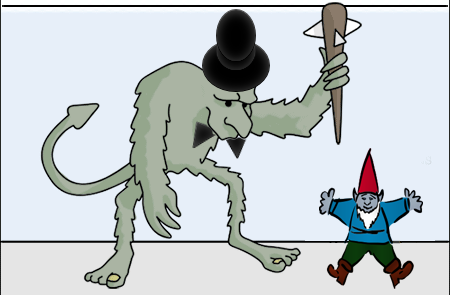
It’s become a bit of shibboleth among the folks who want to roll back the patent reforms of the past decade that patent trolls are a myth. Unfortunately, this week one of those mythical trolls is taking a very real swing at a little GNOME.
The GNOME (Foundation)
The GNOME Foundation is a non-profit that coordinates activities around the open-source GNOME project, an effort to create a free and open-source desktop Linux environment. Many Linux distributions, such as Red Hat, use GNOME as their default environment. It has revenues of approximately $300,000 per year, mostly used to distribute educational materials and put on educational conferences.
The Troll: Rothschild Patent Imaging, LLC
The ‘mythical’ trollAn entity in the business of being infringed — by analogy to the mythological troll that exacted payments from the unwary. Cf. NPE, PAE, PME. See Reitzig and Henkel, Patent Trolls, the Sustainability of ‘Locking-in-to-Extort’ Strategies, and Implications for Innovating Firms. in this case turns out to be a very real one. Rothschild Patent Imaging (RPIL) is one of more than 35 subsidiaries created by a single parent entity, Leigh Rothschild. None of these entities make products. Instead, they exist to provide an entity to hold one patent or set of patents and shield the parent company from liability while asserting the patents—a very real risk, given the Federal Circuit’s characterization of Rothschild entities as engaging in a pattern of vexatious litigation.
The Lawsuit
This week, RPIL filed a lawsuit against the GNOME Foundation, claiming the Shotwell photo manager infringes its patent. Here’s what Rothschild claims to have invented in 2008:
4. A method performed by an image-capturing mobile device, comprising:
receiving a plurality of photographic images;
filtering the plurality of photographic images using a transfer criteria wherein the transfer criteria is a subject identification of a respective photographic image within the plurality of photographic images, wherein the subject identification is based on a topic, theme or individual shown in the respective photographic image; and
transmitting, via a wireless transmitter and to a second image capturing device, the filtered plurality of photographic images.
That’s right. Rothschild thinks he was the first to come up with receiving a bunch of photos on a phone, filtering them based on a topic or theme, and transmitting them wirelessly to someone else’s mobile device.
That’s probably not patentableEligible to be patented. To be patent-eligible, an invention must fall into the categories listed in 35 U.S.C. § 101 (i.e., process, machine, manufacture, or composition of matter) and cannot be an abstract idea or a law of nature. subject matter under the Alice § 101 test. It’s probably not even valid under § 102 or § 103—I was doing exactly this on my MacBook using Lightroom when it was released in 2007, more than a year before the filing of the RPIL patent. A MacBook is an image-capturing mobile device, but even if it isn’t, porting that kind of software from a laptop to a smartphone is obvious. This is a clear example of the kind of patent that never should have been granted that IPRIntellectual Property Rights. Usually associated with formal legal rights such as patent, trademark, and copyright. Intellectual property is a broader term that encompasses knowledge, information, and data considered proprietary whether or not it is formally protected. was designed to deal with.
The Toll
The problem is that, according to AIPLA estimates, even the relatively inexpensive inter partes review procedure costs $325,000-$450,000 to pursue. That’s more than the Foundation takes in in an entire year, and that doesn’t account for the significantly higher cost of patent litigation in the period before the Foundation would hopefully be able to obtain a stay.
Given GNOME’s limited revenues, RPIL probably doesn’t expect GNOME to fight the case, nor does it expect a large judgment if they do. Instead, RPIL is likely hoping for a nuisance-value settlement—a payment of $50,000 or $100,000 to make the case go away. (Of course, that would still be a third of GNOME’s yearly revenue, a significant burden on their educational mission.)
And the situation could be even worse. If the STRONGER Patents Act were to pass—which seems less likely after the strong criticism of the bill at a recent hearing—then trolls like RPIL would be incentivized to go after small companies and foundations like GNOME. RPIL could try to get GNOME to file a relatively weaker IPRIntellectual Property Rights. Usually associated with formal legal rights such as patent, trademark, and copyright. Intellectual property is a broader term that encompasses knowledge, information, and data considered proprietary whether or not it is formally protected. due to its limited resources—and then turn around and sue larger entities, using GNOME’s petition to block their patent from challenges by better funded litigants. The end result would be to increase bottom-feeder litigation like this and the cost of litigation for everyone in the patent system.
Patent trolls with weak patents suing non-profits who make software for everyone’s benefit—this is what bills like the STRONGER Patents Act and attempts to overturn Alice would protect and incentivize.

